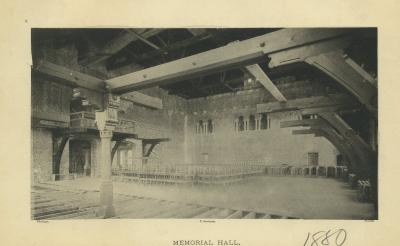With a seating capacity of 728, Gaston Hall, located in Healy Hall, is considered the crown jewel of Georgetown. The first event held in Gaston Hall was the commencement ceremony for Georgetown's class of 1879, which was attended by President Rutherford B. Hayes, and ever since then has been the premiere event site on campus of foreign dignitaries, presidents, Supreme Court Justices, and world-renowned activists.1
Architecture and History
Gaston Hall was named after Georgetown's first student, a jurist and congressman, William Gaston. The naming of Gaston Hall has been a source of controversy in more recent years, because of his problematic past as a slaveowner. Although Gaston Hall was built in the 1880s, the auditorium was not fully completed until 1901. The University had a difficult time finding the funds to complete the hall in the style of the original architect, Paul Pelz. Brother Francis Schroen, funded by the generous donations of the Alumni Association, was the leading artist behind the renovations.
In the designing phases of Gaston, Georgetown's President, Rev. John D. Whitney, S.J., and the librarian, Rev. Henry Shandelle, wrote to Jesuit colleges around the world to send in their seals so that they could be used in the decoration of Gaston Hall. Brother Schroen used these samples collected from Jesuit Universities to design the plaster shields to hang on the walls with the Georgetown seal affixed 2at the center of the stage. Fitting to an institution of higher learning, Brother Schroen inscribed quotes from famous philosophers, saints, poets, and other historical figures. This included famous quotes from Plato, Cicero, Dante, and St.Paul. Brother Schroen combined plaster to give a ribbed effect along the sides of Gaston Hall, in addition to the carved leaves and emblems on the walls. During the renovations, Brother Schroen declared, "It must be symbolical, even to the smallest scroll."3
Inscribed in Gaston are the words Ad Maiorem Dei Gloriam Inque Hominum Salutem, which means "All for the Greater Glory of God and the Wellbeing of Mankind." At the south of the wall is the figure of the goddess Athena and at the north is a classical male figure. The words under both figures combine to make Mens Sana in Corpore Sano, which is the well-known Jesuit precept that a healthy mind is a healthy body. At the center of Gaston is its most poignant and visible allegorical paintings, all representing Georgetown's most important values: Morality, Faith, Patriotism, Art, Alma Mater, Science.
The University celebrated the formal opening of the newly-renovated Gaston Hall in 1901 to the music of the United States Marine Band.4
Modern Use
Since its opening in 1901, Gaston Hall has been the site of the University's most important events, panels, and speakers. Political figures such as former presidents Obama, Bush, Ford, and Clinton, as well as public figures such as Mark Zuckerberg, Warren Buffett, and Bradley Cooper have all appeared in Gaston Hall. There was a small controversy in 2009 when the White House asked Georgetown to cover up religious symbols on the stage of Gaston Hall to provide a neutral backdrop for President Obama's speech.
Gaston Hall is also used for student performances such as Rangila, the student-led dance performance showcasing South Asian culture, as well as the DCA Capella Festival, an a capalla performance co-hosted by Georgetown Gracenotes and the Phantoms. 5
- 1https://library.georgetown.edu/exhibition/gaston-hall-visitors-and-events
- 2Keeler, Virginia M. "The Search for Freedom, and Freedom Found: The Life and Art of Brother Francis C. Schroen," Master's Thesis, Georgetown University, 1989
- 3Lewis, Jo Ann. "Gaston Hall," The Washington Post Magazine, Dec 23, 1990
- 4Sichler, Joe. "Gaston Hall Rich in Hilltop Traditions; Long Past Hid Behind Victorian Decor." The Hoya, 3 March 1960.
- 5Malcolm, Andrew. "Opinion: Obama White House ordered coverup of religious symbols for Georgetown speech."The LA Times, Apr 16, 2009. https://www.latimes.com/archives/blogs/top-of-the-ticket/story/2009-04-16/opinion-obama-white-house-ordered-coverup-of-religious-symbols-for-georgetown-speech




